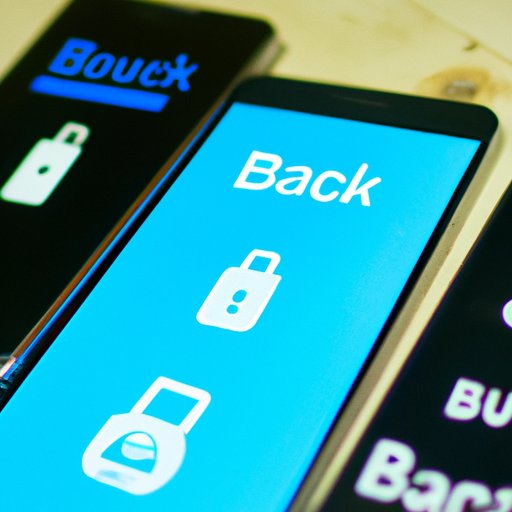
Introduction
It’s commonly known that you should always backup important data and files on your computer, but what about your Android phone? Smartphones and tablets have become a crucial part of our daily lives, and we often store sensitive and valuable data on them. From our contacts, photos, and messages to files and applications, the data on our phones is critical. Losing it due to unexpected events like theft, damage, or a factory reset would be disastrous. Therefore, it’s important to have a comprehensive phone backup plan in place. In this guide, we’ll explore different ways to backup an Android phone, catering to all levels of technical experience and all types of data.
Using Google Backup
If you use an Android phone, you should leverage Google Backup. It’s a native Android backup feature integrated into Google Play Services that automatically backs up your data to the cloud. Here are the steps to set up:
- Go to your phone’s Settings App and select System
- Locate Backup and select it
- Turn on the toggle switch, and then scroll down to choose what data you want to backup
- Click on ‘Back up now’ to take an instant backup, as and when needed
Google Backup advantages:
- Easy to use
- Data is secured on Google servers
- Automatic backup
You can back up the following types of data using Google Backup:
- Contacts
- Calendar
- Call history
- Photos and videos (if you use Google Photos)
- App and settings data
Manual Backup
If you’re more comfortable with physical methods of backup, manually backing up your phone may be a good option for you. You can back up photos, videos, music, and documents to your PC, laptop, or external drive. Here are two ways to do it:
- Using a Computer: Using a USB or a USB-C cable, connect your phone to the computer and transfer the data you want to backup to your computer. You can also use Windows Explorer or Android File Transfer to move files between devices.
- Using an External Drive: Connect your phone to an external drive, and drag-and-drop the files you want to backup to the drive.
Advantages of manual backup:
- More control over backing up what is important
- No need for an internet connection
- Doesn’t require a third-party app
Third-Party Backup Apps
Third-party backup apps offer more flexibility than built-in backup methods. While there are many backup apps available, some of the most popular ones are Helium Backup, Titanium Backup, and My Backup.
Pros and cons of using third-party backup apps:
- More customizable and feature-rich
- May require a little more technical knowledge
- Some apps aren’t free, and you may need to purchase to access all features
If you decide to use a third-party backup app, you can follow these general steps:
- Download and install the app from the Google Play Store
- Launch the app and choose what type of data you want to backup
- Select a backup location
- Follow the instructions given by the app
Cloud Services
Cloud services are one of the easiest and efficient ways to backup your phone data. Generally, cloud services provide free storage for your data, and you can access them anytime from anywhere with an internet connection. Some popular cloud services are Google Drive, Dropbox, and OneDrive. Here’s how to backup using Google Drive:
- Sign in to your Google account on your phone
- Install Google Drive from the Google Play Store if you don’t have it already
- Open Google Drive and select ‘backup settings’
- Turn on backup for the data you want to backup, such as photos, contacts, and settings
Cloud services advantages:
- Easily accessible from anywhere with an internet connection
- Automatic backups
- Most cloud services offer free storage
Built-in Backup
Most phones come equipped with built-in backup mechanisms. Samsung Smart Switch App or LG’s Backup app are good examples.
Details on what data can be backed up using built-in mechanisms:
- Samsung Smart Switch App: Contacts, Calendar, Messages, Photos, Videos, and Documents
- LG’s Backup app: Contacts, Calendar, Call logs, Messages, Photos, Music, Videos, and Documents
Here’s how to use Samsung Smart Switch App:
- Download and install the Smart Switch app from the Google Play Store
- Launch the app and click on ‘Wireless Transfer’ or ‘USB Cable Transfer,’ depending on what is most convenient for you
- Follow the prompts given by the app
SD Card Backup
Backing up data using an SD card is an excellent option if you have a lot of photos and videos that you want to keep in one place. It’s also a great option if you are traveling and need to keep a backup with you. Here’s how:
- Insert the SD card into your phone
- Go to your Settings app and click on Storage
- Click on ‘Backup and restore’ and then click on ‘Backup my data’
- Select the SD card as the storage location for the backup files
Remember to keep your SD card safe from data loss or damage by keeping it in a safe and protective case.
Conclusion
Backing up data from your Android phone is a crucial step to ensure that you never lose your important files and data. In this article, we explored different methods of Android backup, including Google Backup, manual backup, third-party backup apps, cloud services, built-in backup, and SD card backup. By taking regular backups of your phone, you can rest easy knowing that your data is safe and secure. Moreover, we encourage readers to regularly backup their data to ensure their data isn’t lost in unexpected events. Lastly, ensure that you keep your backup data safe and accessible by following the correct procedures.




